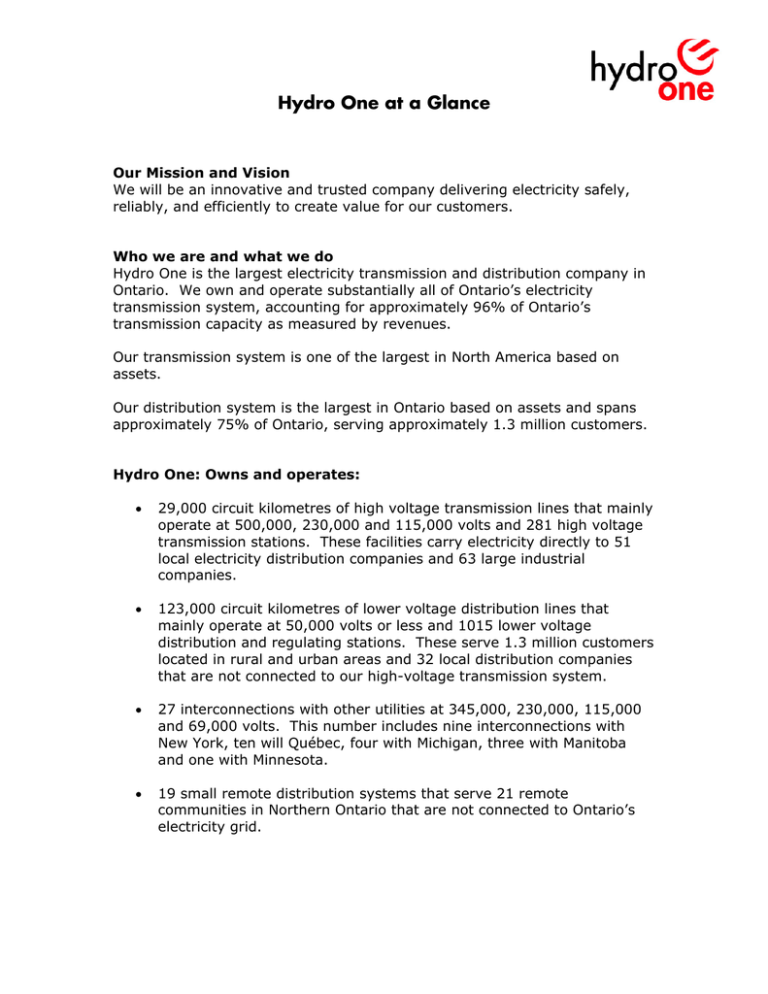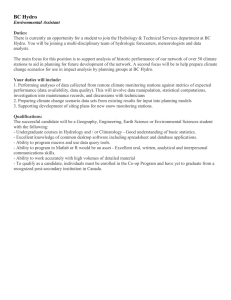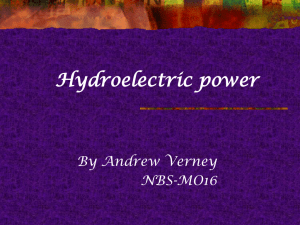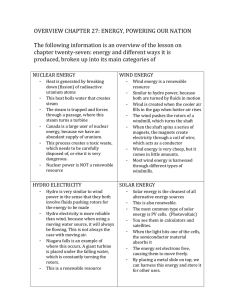Hydro One at a Glance
advertisement

Hydro One at a Glance Our Mission and Vision We will be an innovative and trusted company delivering electricity safely, reliably, and efficiently to create value for our customers. Who we are and what we do Hydro One is the largest electricity transmission and distribution company in Ontario. We own and operate substantially all of Ontario’s electricity transmission system, accounting for approximately 96% of Ontario’s transmission capacity as measured by revenues. Our transmission system is one of the largest in North America based on assets. Our distribution system is the largest in Ontario based on assets and spans approximately 75% of Ontario, serving approximately 1.3 million customers. Hydro One: Owns and operates: • 29,000 circuit kilometres of high voltage transmission lines that mainly operate at 500,000, 230,000 and 115,000 volts and 281 high voltage transmission stations. These facilities carry electricity directly to 51 local electricity distribution companies and 63 large industrial companies. • 123,000 circuit kilometres of lower voltage distribution lines that mainly operate at 50,000 volts or less and 1015 lower voltage distribution and regulating stations. These serve 1.3 million customers located in rural and urban areas and 32 local distribution companies that are not connected to our high-voltage transmission system. • 27 interconnections with other utilities at 345,000, 230,000, 115,000 and 69,000 volts. This number includes nine interconnections with New York, ten will Québec, four with Michigan, three with Manitoba and one with Minnesota. • 19 small remote distribution systems that serve 21 remote communities in Northern Ontario that are not connected to Ontario’s electricity grid. How Hydro One’s System Works Hydro One’s electricity system is illustrated below: In rural areas and in some small and medium urban areas, Hydro One carries electricity all the way from the generator to the final end user. In medium and large urban areas, Hydro One’s system ends at the step down transformer station at the bottom of the drawing. In an urban area that step-down transformer station would typically be a shared facility with the local electrical utility. Hydro One would own the high-voltage lines coming into the station, and the local utility such as Enersource Hydro Mississauga or Hydro Ottawa would own the lower-voltage lines coming out of it. What can go cause a power outage? For electricity to flow successfully, all equipment from the generating station right through to the end user must work. Any interruption along the line can cause the power to go out. For example: • A car could hit a power pole damaging a line or a transformer. • Animal contact with electricity equipment. • A transformer could overheat and fail. • Lightening could cause an electrical surge causing protective switches called circuit breakers to shut off the power. • Lines could overheat and fail. • Trees could contact lines and cause a short circuit. • Vandalism such as hunters shooting at electrical insulators could cause a line to short out. When this happens circuit breakers automatically shut off the power. To minimize power interruptions, Hydro One takes many precautions: Redundancy: Almost everything up to and including the final step-down transformer station has two or more backup systems. Most step-down transformer stations can be supplied by two or more high-voltage lines, and typical stepdown transformer stations contain two transformers either one of which can support the entire load of the station. As a result, failures in the high-voltage system rarely cause a power interruption because power can be switched automatically to another source of supply. This allows time for the failed equipment to be repaired or replaced to restore the redundancy of the system. The lower-voltage system from the step-down transformer to the end user is often not redundant. If failures occur here, the problem must be fixed before power can be restored. Preventative Maintenance: Hydro One constantly inspects its transmission and distribution lines and stations. Hydro One also practices reliability centred maintenance. This maintenance system predicts equipment failures based on usage data and replaces equipment before it fails. For example, circuit breakers wear out according to the number of operations they undergo. A ten-year old circuit breaker on a line that rarely experiences an interruption might be a good as new, while the same breaker on a very active line might need replacement. By tracking actual operations of electrical equipment, it is possible to design a maintenance program that is both cost effective and that improves reliability. Crews always on call: Hydro One always has a number of its maintenance staff on call ready to go 24/7. This allows us to respond quickly to sudden outages caused by storms, forest fires or other natural disasters. How does electricity enter Toronto? This map shows how electricity gets to where it is used in Toronto. The red lines are 500,000 volt transmission lines, the blue lines are 230,000 volt transmission lines and the green lines are 115,000 volt transmission lines. Many of the green lines in the heart of the city are underground transmission cables. Electricity comes into Toronto through two key transmission stations one in the east and one in the west (marked with arrows). From these two stations, electricity can be directed in many different ways throughout the city. All this switching is carried out remotely from Hydro One’s Ontario Grid Control Centre (OGCC) and can also be carried out from our Reserve Grid Control Centre located a considerable distance from the OGCC. Alternatively, switching can be carried out manually by Hydro One’s highly-trained staff.




